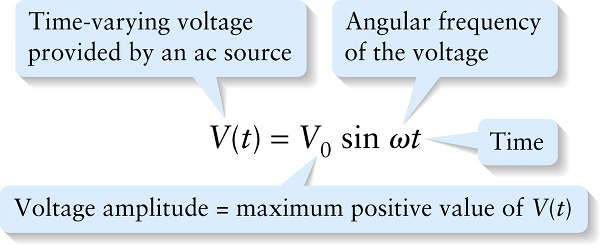Voltage of an ac source (21-1)
Question 1 of 4
Question
Voltage amplitude = maximum positive value of \(V(t)\)
{"title":"Time-varying voltage provided by an ac source","description":"Wrong","type":"incorrect","color":"#99CCFF","code":"[{\"shape\":\"poly\",\"coords\":\"82,133\"},{\"shape\":\"rect\",\"coords\":\"10,16,12,16\"},{\"shape\":\"poly\",\"coords\":\"144,22\"},{\"shape\":\"rect\",\"coords\":\"4,1,35,45\"}]"} {"title":"Angular frequency of the voltage","description":"Incorrect","type":"incorrect","color":"#ffcc00","code":"[{\"shape\":\"rect\",\"coords\":\"254,17,284,41\"}]"} {"title":"Time","description":"Wrong","type":"incorrect","color":"#333300","code":"[{\"shape\":\"rect\",\"coords\":\"286,13,301,41\"}]"} {"title":"Voltage amplitude = maximum positive value of V sub (t)","description":"Correct!","type":"correct","color":"#000080","code":"[{\"shape\":\"rect\",\"coords\":\"128,4,163,41\"}]"}Review
Figure 21-2 graphs the voltage \(V(t)\) a function of time. The angular frequency \(\omega\) of the voltage (in rad/s) is related to the frequency \(f\) of the voltage (in Hz) by the same relationship we used in Section 12-3 for simple harmonic motion.

